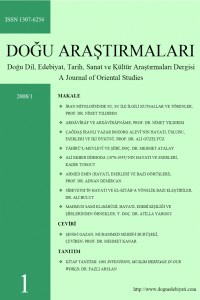YAHUDİ ESKATOLOJİSİNDE ARMİLUS
Bütün semâvî dinler, evrenin yaratılışıyla ilgili çeşitli teoriler ileri sürdükleri gibi dünyanın son zamanlarında yaşanacaklar hakkında da bir takım kehanetlerde bulunmuşlardır. Bu kehanetlerin merkezi noktasında gelmesi beklenen bir kurtarıcı Mesîh inancı bulunur. Kurtarıcının gelmesinden önce ve sonra yaşanacaklara dair kehanetler de bu inancın tamamlayıcı parçaları olmuştur Araştırmamızın ana ekseni, Yahudilikte beklenen kurtarıcı Mesîh’in gelmesinden hemen önce ortaya çıkacağına inanılan kötülük figürlerinden Armilus’tur. Asırlar boyunca sürgün hayatı yaşayan Yahudiler, kendilerine zulmeden çeşitli devletleri ya da komutanları başta Armilus olmak üzere çeşitli kavramlarla açıklamışlardır. Özellikle apokaliptik ve midraşik türde yazılmış eserlerde canlı bir şekilde tasvir edilen Armilus, Yahudilerin ahir zamandaki en büyük düşmanı olarak kabul edilir. Anlatımlara göre, olağanüstü güçlere sahip korkutucu bir görünümü olan Armilus, Yahudilere daha önceki dönemlerde hiç yaşamadıkları sıkıntılı bir dönem yaşatacak ve onlara zulmedecektir. Nihayetinde ise Tanrı, Mesîh’i gönderip Armilus’u öldürmek suretiyle Yahudilere yardım edecektir. Böylelikle Yahudilerin asırlar boyunca bekledikleri kurtuluş dönemi başlayacaktır. Araştırmamızda Armilus isminin kökeni ve onun çeşitli apokaliptik ve midraşik eserlerde nasıl ele alındığı üzerinde durulmuştur. Sonuç bölümünde ise genel bir değerlendirme yapılmıştır
ARMILUS IN JEWISH ESCHATOLOGY
All monotheistic religions propounded various theories about the creation of the world as they prophesied about the happenings at the end of the world. The belief in an expected savior Messiah is at the central point of these prophecies. The prophecies about the happenings appertaining to before and after coming of the savior are complementary parts of this belief. considered to be as the biggest enemy of Jews at the end of the world. According to the narration, Armilus who has an extraordinary power and a frightening appearance, will give the Jews a hard time that they never had before and will persecute them. Eventually, God will help to the Jews by means of sending the Messiah to them and killing Armilus. By this way the salvation period that the Jews waited for centuries will begin soon. In our research, we have focused on the origin of the name Armilus and how it was discussed in various apocalyptic and midrashich works. In the conclusion, an overall assessment are made
___
- BAĞIR, Muhammed Ali, Dinler Tarihi Açısından Saadia Gaon’un Hayatı, Eserleri ve Yahudi İnanç Tarihine Etkisi, (Erciyes Üniversitesi Sosyal Bilimler Enstitüsü, Basılmamış Doktora Tezi), Kayseri 2014.
- BATUK, Cengiz, Tarihin Sonunu Beklemek Ortadoğu Dinlerinde Eskatoloji Mitosları, İz Yayıncılık, İstanbul 2003.
- BERGER, David, “Three Typological Themes in Early Jewish Messianism: Messiah Son of Joseph, Rabbinic Calculations, and the Figure of Armilus, Association for Jewish Studies (AJS) Review, Vol. 10, No. 2, Autumn 1985, s. 141-164.
- BURGANSKY, Israel-Stephen G. Wald, “Simeon Bar Yohai”, Encyclopaedia Judaica (EJ), Vol. XVIII, Second Edition, (Edi. in Chief Fred Skolnik, Executive Edi. Michael Berenbaum), Macmillan Reference, Detroit USA 2007, s. 593-594
- DAN, Joseph “Armilus: The Jewish Antichrist and The Origins and Dating of Sefer Zerubbavel”, Toward the Millennium: Messianic Expectations from the Bible to Waco, Edi. Peter Schäfer ve Mark Cohen, Brill Publishing, Leiden 1998, s. 73-104.
- DEMİRCİ, Kürşat, “Deccal”, Türkiye Diyanet Vakfı İslam Ansiklopedisi, C. IX, İstanbul 1994, s. 67-69.
- DUBNOV, Simon, History of Jews, Volume 2: From the Roman Empire to the Early Medieval Period, Translated by Moshe Spiegel, A. S. Barnes and Co. Inc., USA 1968.
- EL-FEYYÛMÎ, Sa’id b. Yusuf (Saadia Gaon), Kitâb al-Amânât va’l-I’tiqâdât, Hazırlayan Dr. Samuel Landauer, E.J. Brill, Leiden 1880.
- HERR, Moshe David, “Midrashim, Smaller”, Encyclopaedia Judaica (EJ), Volume XIV, Second Edition, (Edi. in Chief Fred Skolnik, Executive Edi. Michael Berenbaum), Macmillan Reference, Detroit USA 2007, s. 189.
- HIMMELFARB, Martha, “Sefer Zerubbabel”, Rabbinic Fantasies: Imaginative Narratives from Classical Hebrew Literature, Edi. David Stern and Mark Jay Mirsky, Yale University Press, First Edition, 1998, s. 67-90.
- HIMMELFARB, Martha, The Apocalypse: A Brief History, Wiley-Blackwell, Oxford 2010.
- KLATZKIN, Jacob, “Armilus”, Encyclopaedia Judaica (EJ), Vol. II, Second Edition, (Edi. in Chief Fred Skolnik, Executive Edi. Michael Berenbaum), Macmillan Reference, Detroit USA 2007, s. 474-475.
- MARMONSTEIN, Arthur, “The Doctrine of Redemption In Saadya’s Theological System”, Saadya Studies: In Commemoration of the One Thousandth Anniversary of the Death of R. Saadya Gaon, Edi. Erwin Isak Jacop Rosenthal, Manchester University Press, Manchester 1943, s. 103-118.
- MIKVA, Rachel S., Midrash Vayosha and The Development Of Narrative In Medieval Jewish Exegesis, (The Graduate School of The Jewish Theological Seminary, Ph.D. Thesis), USA 2008.
- NEL, Marius “The Signs of the Messiah (‘Otot Hamashiach) and Jewish Apocalypticism”, The Journal of Early Christian History, Volume 2, Issue 2, 2012, s. 63-78.
- REEVES, John C., Trajectories in Near Eastern Apocalyptic: A Postrabbinic Jewish Apocalypse Reader, Society of Biblical Literature, USA 2005.
- SACRAMENTO,Michel, Three Apocalypses of the Early Muslim Period in the Context of Confrontations, Cardiff University, (Ph.D. Thesis), UK 2005
- SARACHEK, Joseph, The Doctrine of the Messiah in Medieval Jewish Literature, Jewish Theological Seminary of America, New York 1932.
- SELIGSOHN, Max, “Simeon ben Yohai”, The Jewish Encyclopedia (JE), Vol. XI, Funk and Wagnals Company, New York 1905 s. 359-362.
- SILVER, Abba Hillel, A History of Messianic Speculation in Israel: From the First Through the Seventeenth Centuries, The Macmillan Company, New York 1927.
- STAVE, Eric, “Ahriman”, The Jewish Encyclopedia (JE), Vol. I, Funk and Wagnals Company, New York 1905, s. 296.
- TOPRAK, Mehmet Sait, Talmud ve Hadis Karşılaştırmalı Bir
- Araştırma, Kabalcı Yayıncılık, İstanbul 2012
- ISSN: 1307-6256
- Yayın Aralığı: Yılda 2 Sayı
- Başlangıç: 2008
- Yayıncı: Ali GÜZELYÜZ
